 Who is the blogger?
Who is the blogger?
To see a simple English version of reviews about some of the movies, click on the ESL section of Midnight Oil.
Places in the Heart (1984)

In “Places in the Heart” (1984), writer/director Robert Benton delivers a poignant portrait of a way of life as it once was in the deep South during the Depression era. Edna Spalding (played by Sally Field) finds herself in an unexpected place, facing life as a widow with two young children after her husband is suddenly killed. Edna seems to represent many women of her  generation. She is ill-prepared to deal with the harsh realities of being a single parent in what is still very much a man’s world. She doesn’t even know how to write out a cheque, much less run a farm and earn a living. Sally Field’s character demonstrates courage, warmth and toughness in the face of overwhelming odds as she attempts to
generation. She is ill-prepared to deal with the harsh realities of being a single parent in what is still very much a man’s world. She doesn’t even know how to write out a cheque, much less run a farm and earn a living. Sally Field’s character demonstrates courage, warmth and toughness in the face of overwhelming odds as she attempts to 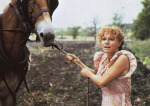 keep her family together during a deep economic and personal crisis.
keep her family together during a deep economic and personal crisis.
Danny Glover’s portrayal of the character Moze, a migrant worker who ends up helping Edna to work the farm and bring in the cotton, captures the essence 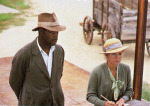 of the situation of the black man in this period of time. Moze searches not only for work to keep body and soul together, but for dignity to make life worth living. He finds both for just a moment with Mizz Spalding on a little farm just outside of the small town of Waxahachie, Texas.
of the situation of the black man in this period of time. Moze searches not only for work to keep body and soul together, but for dignity to make life worth living. He finds both for just a moment with Mizz Spalding on a little farm just outside of the small town of Waxahachie, Texas.
 John Malkovich plays Mr. Will, a complicated character whose injuries from the First Great War involve more than just the loss of his eyesight. As a boarder in the household, Mr. Will temporarily finds a place to belong and a group of people who need him almost as much as he needs to be needed.
John Malkovich plays Mr. Will, a complicated character whose injuries from the First Great War involve more than just the loss of his eyesight. As a boarder in the household, Mr. Will temporarily finds a place to belong and a group of people who need him almost as much as he needs to be needed.
Benton frames his semi-autobiographical work with bookends in the form of two hymns that open and close the film. (See below) These scenes set up a  context for understanding the rest of the action of the film. As with the folksy irregular rhythm of the cotton pickin’ ballads in the middle of the movie, the music comes out of the real life experiences of the townspeople. The music is presented as something that’s a part of what the people here really live. It’s not just an ornamental backdrop for the dramatic action.
context for understanding the rest of the action of the film. As with the folksy irregular rhythm of the cotton pickin’ ballads in the middle of the movie, the music comes out of the real life experiences of the townspeople. The music is presented as something that’s a part of what the people here really live. It’s not just an ornamental backdrop for the dramatic action.
The final scene with the communion in church raises particular issues. Everything else in the film has been firmly anchored in reality until the final frames of the film. Why is it that unreality suddenly takes over? Edna’s dead husband and his killer, the young black man, who was brutally killed by a lynch mob, suddenly appear sitting in church. Sitting there in the pew, they seem as normal as every other member of the community as the communion plate is passed. My thought is that it has to do with what  Robert Benton wants to show us about his main characters and the community they live in. “Places in the Heart” may be a memory of a place and a time that no longer exist. The magic in it is that Benton manages to help us to understand something of what it was like to live there and then, just as he lived it.
Robert Benton wants to show us about his main characters and the community they live in. “Places in the Heart” may be a memory of a place and a time that no longer exist. The magic in it is that Benton manages to help us to understand something of what it was like to live there and then, just as he lived it.
See the TVO Saturday Night at the Movies in depth Interviews as the subject of "Surviving the Depression" is treated in two films shown on SNAM: "Places in the Heart" (1984) and "Pennies from Heaven"(1981).
>>Real Life: Everything in life seemed to be going fine. That all changed the day Tamara learned she had incurable cancer and was faced with only a few uncertain years to live. Where do you turn when confronted with a no-win situation?
>>More to see: Looking for more out of life?
See the framing opening and closing scenes with accompanying music from "Places in the Heart".
Priest (1994)
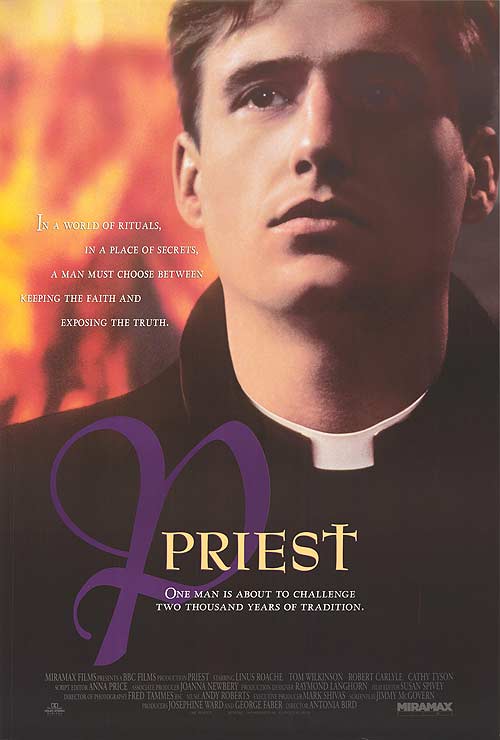 “Priest” (1994) is a difficult movie tackling a difficult subject. It holds up for scrutiny the many conflicts of being a modern-day Roman Catholic priest. Upon arrival at his new parish, Father Pilkington (Linus Roache) quickly becomes embroiled in a series of no-win situations. His fellow priest (Tom Wilkinson) is
“Priest” (1994) is a difficult movie tackling a difficult subject. It holds up for scrutiny the many conflicts of being a modern-day Roman Catholic priest. Upon arrival at his new parish, Father Pilkington (Linus Roache) quickly becomes embroiled in a series of no-win situations. His fellow priest (Tom Wilkinson) is  having a clandestine affair with the maid; a young parishioner reveals while in the confessional that she is the victim of incest; and he himself is caught in compromising circumstances in an ongoing homosexual relationship. The ready answers of Father Greg’s conservative version of Roman Catholic faith appear to be no match for the very real problems of real life in his very ordinary English parish. A crisis of faith ensues for Father Greg. His fellow clergy and the parish in general are dragged along unwittingly and unwillingly.
having a clandestine affair with the maid; a young parishioner reveals while in the confessional that she is the victim of incest; and he himself is caught in compromising circumstances in an ongoing homosexual relationship. The ready answers of Father Greg’s conservative version of Roman Catholic faith appear to be no match for the very real problems of real life in his very ordinary English parish. A crisis of faith ensues for Father Greg. His fellow clergy and the parish in general are dragged along unwittingly and unwillingly.
Although most of the crises in the film revolve around the 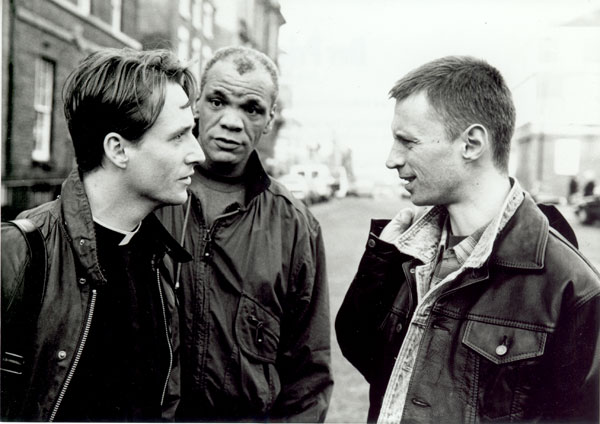 depiction of a mangled sexuality, on a more global level, the sex is just a window through which to see more deeply into the soul, into what it means to be human. In spite of the brouhaha that the film engendered when originally released, this film endures in its
depiction of a mangled sexuality, on a more global level, the sex is just a window through which to see more deeply into the soul, into what it means to be human. In spite of the brouhaha that the film engendered when originally released, this film endures in its  unflinching look at a certain situation in the Church today. That being said, the film is not totally devoid of either the hope or the redemption that the Church is supposed to be famous for. Like the rest of what is depicted in the film, it’s just not that simple.
unflinching look at a certain situation in the Church today. That being said, the film is not totally devoid of either the hope or the redemption that the Church is supposed to be famous for. Like the rest of what is depicted in the film, it’s just not that simple.
>> Real Life : Jarrett found a way out of the guilt and shame caused by a child molester who was a trusted figure during his childhood.
>>More to see: Looking for more out of life?
See the video trailer for "Priest" (1994).
Compulsion (1959)
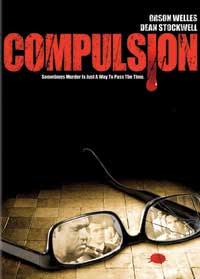 Compulsion (1959) is an interesting twist on the infamous thrill killing "Crime of the Century" committed by Leopold and Loebin the 1920s.
Compulsion (1959) is an interesting twist on the infamous thrill killing "Crime of the Century" committed by Leopold and Loebin the 1920s.  Historically, the case had influence in America in ending the death penalty for murder. Dean Stockwell and Bradford Dillman play the rich young degenerates who engage in the most shocking of crimes. Orson Welles plays Clarence Darrow, the defense lawyer who is responsible for helping them to avoid the hangman's noose. The award winning performances lead one through a thorough workout
Historically, the case had influence in America in ending the death penalty for murder. Dean Stockwell and Bradford Dillman play the rich young degenerates who engage in the most shocking of crimes. Orson Welles plays Clarence Darrow, the defense lawyer who is responsible for helping them to avoid the hangman's noose. The award winning performances lead one through a thorough workout 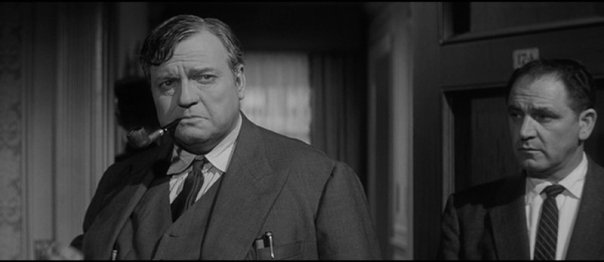 for the moral faculties on issues of captial punishment.
for the moral faculties on issues of captial punishment.
>> Real Life: James wound up in jail after killing someone while drinking and driving. He lost everything before things turned around for him.
>> More to see: looking for more out of life?
See the Clarence Darrow summation scene by Orson Welles in "Compulsion" (1959)
Apollo 13 (1995)
“Apollo 13” (19 95), directed by Ron Howard, provides a wonderfully realistic dramatization of the historic aborted moon voyage of 1970. There was a PG rating on the film for language and emotional intensity. I appreciated the warning as the parent of a 10 year old who remains fascinated by gadgets, gizmos and galaxies but who
95), directed by Ron Howard, provides a wonderfully realistic dramatization of the historic aborted moon voyage of 1970. There was a PG rating on the film for language and emotional intensity. I appreciated the warning as the parent of a 10 year old who remains fascinated by gadgets, gizmos and galaxies but who  gets slightly stressed out by the super suspenseful inner states of being that sell movies. You really do want to make sure that you go to the bathroom before you start out on this two hour “disasterful” cinematic voyage to the moon and back. Tom Hanks, Bill Paxton and Kevin Bacon (playing astronauts Lovell, Haise and Swigert) form a triumvirate for outer space. Ed Harris provides ground support as Flight Director Gene Kranz. Well, there was that other guy, Gary Sinise. He plays astronaut Ken Mattingly. That’s the fellow who gets knocked off of the roster at the last minute by
gets slightly stressed out by the super suspenseful inner states of being that sell movies. You really do want to make sure that you go to the bathroom before you start out on this two hour “disasterful” cinematic voyage to the moon and back. Tom Hanks, Bill Paxton and Kevin Bacon (playing astronauts Lovell, Haise and Swigert) form a triumvirate for outer space. Ed Harris provides ground support as Flight Director Gene Kranz. Well, there was that other guy, Gary Sinise. He plays astronaut Ken Mattingly. That’s the fellow who gets knocked off of the roster at the last minute by  German measles - but no one ever mentions him. They did manage, in the name of historical accuracy, to mention the fact that the unfortunate Pilot Haise, played by Bill Paxton, got a major urinary tract infection due to not drinking enough water during the mission. Too much information.
German measles - but no one ever mentions him. They did manage, in the name of historical accuracy, to mention the fact that the unfortunate Pilot Haise, played by Bill Paxton, got a major urinary tract infection due to not drinking enough water during the mission. Too much information.
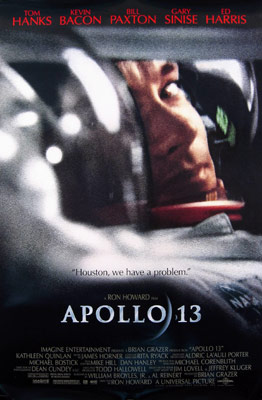 Methinks there was a bit too much testosterone floating around the stratosphere in this film. In the end, everyone keeps their head and all get back to earth safely. I really wasn’t sure there for a few minutes – and that was after seeing the film previously and living through the historical event. When they are done right, movies can be an engrossing form of storytelling. This one was done right.
Methinks there was a bit too much testosterone floating around the stratosphere in this film. In the end, everyone keeps their head and all get back to earth safely. I really wasn’t sure there for a few minutes – and that was after seeing the film previously and living through the historical event. When they are done right, movies can be an engrossing form of storytelling. This one was done right.
>>More to see: Looking for more out of life?
>>Real Life Story: Darrell Waltrip was a great success as a NASCAR driver until a near fatal accident changed his direction in life.
View the video trailer for "Apollo 13" (1995)
Starting Out in the Evening (2007)
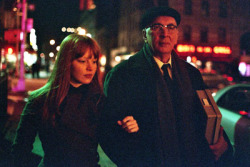 “Starting Out in the Evening” (2007) is actually a film about more than just writers and the craft of writing. It’s about family, career, ambition, following one’s passions, facing death and disappointments . . . and probably a few other things along the way.
“Starting Out in the Evening” (2007) is actually a film about more than just writers and the craft of writing. It’s about family, career, ambition, following one’s passions, facing death and disappointments . . . and probably a few other things along the way.
 Some may find the film a bit slow and obsessively internally focused. What else can one expect? After all, it’s about the world and the process of being a writer, for goodness sake. (Well, actually, we’re not really too sure for whose sake any of this writing stuff is really for in the end. It seems to me that the film desperately wants to convince us that art for art’s sake is its own reason for being.)
Some may find the film a bit slow and obsessively internally focused. What else can one expect? After all, it’s about the world and the process of being a writer, for goodness sake. (Well, actually, we’re not really too sure for whose sake any of this writing stuff is really for in the end. It seems to me that the film desperately wants to convince us that art for art’s sake is its own reason for being.)
Leonard Schiller has lived the life of a New York intellectual. He now has lots of time to reflect on whether it has all been worth it as he faces the illness and incapacity of old age. He’s been stuck with a bad case of writer’s block for years now. It is high time to face up to the truth: neither he nor the characters of his latest novel are going anywhere. A bright young grad student (Lauren Ambrose) intent on 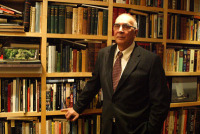 building her own career helps Schiller to realize that he has been following his characters around for years in vain, “waiting for them to do something interesting”. Schiller is faced in the end with a moral dilemma that cuts to the core of his artistic and personal integrity. Does he have the courage to face life the way it really is with its disappointments and limitations and still engage fully in the creative process? Will he do it this time in a wiser, less self-centred way?
building her own career helps Schiller to realize that he has been following his characters around for years in vain, “waiting for them to do something interesting”. Schiller is faced in the end with a moral dilemma that cuts to the core of his artistic and personal integrity. Does he have the courage to face life the way it really is with its disappointments and limitations and still engage fully in the creative process? Will he do it this time in a wiser, less self-centred way?
Schiller’s daughter, Ariel, has a different dilemma. Her life as a former dancer is anchored in a much more physical day-to-day reality, in  contrast to her father’s intellectual pursuits. Ariel has to face her own moral dilemmas and internal wrestlings as she processes what it means to her to be pushing 40 and still be childless. Conflicted desires and yearning for fulfillment bubble up as she faces the mandatory “early retirement” of her dancing career and encounters a former lover who has other priorities in life. (See the video clip.)
contrast to her father’s intellectual pursuits. Ariel has to face her own moral dilemmas and internal wrestlings as she processes what it means to her to be pushing 40 and still be childless. Conflicted desires and yearning for fulfillment bubble up as she faces the mandatory “early retirement” of her dancing career and encounters a former lover who has other priorities in life. (See the video clip.)
Not the film to see if you’re in the mood for an adrenalin rush or up for mindless movie-watching with lots of microwave popcorn on hand . . . It certainly does have its merits though. If you’re not in a rush, why not spend a couple of hours mulling things over with this engaging piece of cinema.
>>More to see: Looking for more out of life?
>>Real Life Story: Successful author, Anne Rice, tells of how the exploration of her personal demons led to writing a series of vampire novels before taking a surprising twist later on in her professional life.
Understand more about "The Written Life" as depicted in SNAM's Interviews about two films which take on the subject of authors and the work of the author. The films described in the Interviews are "Starting Out in the Evening" (2007) and "Infamous" (2006).
See the trailer for "Starting Out in the Evening" (2007)




